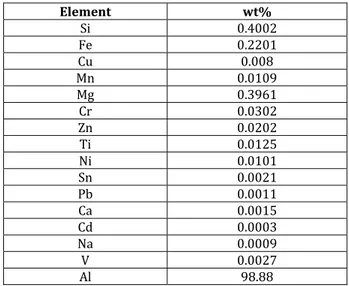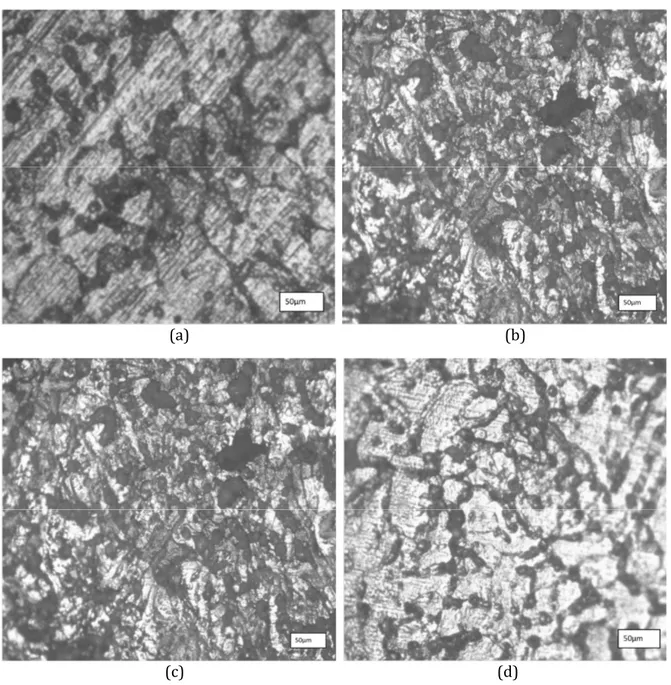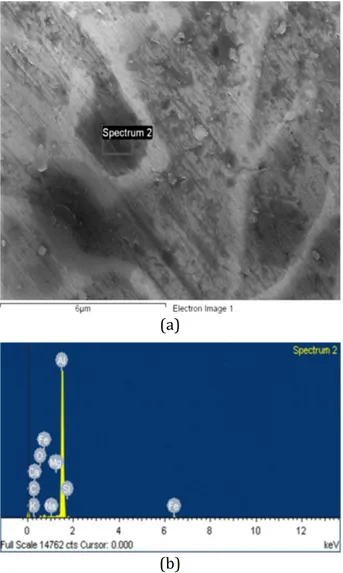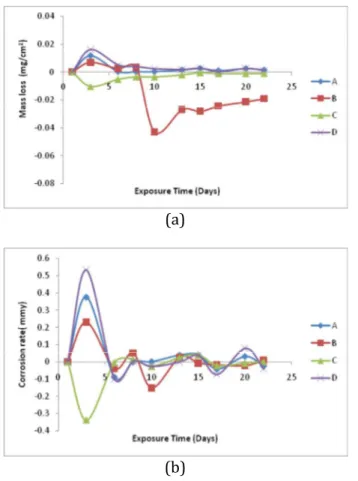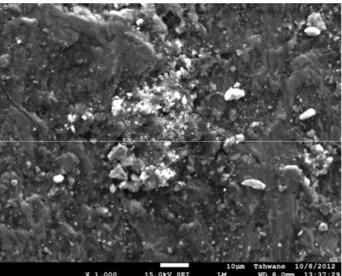Tribology
in
Industry
www.tribology.fink.rsMechanical
Properties
and
Corrosion
Behaviour
of
Aluminium
Hybrid
Composites
Reinforced
with
Silicon
Carbide
and
Bamboo
Leaf
Ash
K.K. Alaneme
a, B.O. Ademilua
a, M.O. Bodunrin
aaDepartmentofMetallurgicalandMaterialsEngineering,FederalUniversityofTechnology,Akure,P.M.B704,Nigeria.
Keywords:
Hybridcomposites
Bambooleafash
Al‐Mg‐Sialloy Corrosion
Stircasting
Mechanicalproperties
Siliconcarbide
A B S T R A C T
The viability of developing low cost – high performance Al matrix hybrid
compositeswiththeuseofbambooleafash(anagrowasteash)andsilicon
carbideascomplementingreinforcementswasinvestigated.Silicon carbide
(SiC)particulatesaddedwith0,2,3,and4wt%bambooleafash(BLA)were
utilizedto prepare10 wt%of thereinforcing phasewithAl‐Mg‐Si alloyas
matrixusingtwo‐stepstircastingmethod.Microstructuralcharacterization,
mechanical properties evaluation and corrosion behaviour were used to
assess the performance of the composites. The results show that the
hardness, ultimate tensile strength, and percent elongation of the hybrid
compositesdecreasewithincreaseinBLAcontent.Thefracturetoughnessof
thehybridcompositeswerehoweversuperiortothatofthesinglereinforced
Al ‐ 10wt%SiCcomposite.Onlythe2wt%BLAcontaininghybridcomposite
had specific strength value comparable to that of the single reinforced
composite. In5wt% NaCl solution,it was observedthatthe 2 and 3wt %
BLA containing hybrid composites had higher corrosion resistance in
comparison to the single reinforced Al ‐ 10 wt% SiC composite but the
reverse trend was observed in 0.3 M H2SO4 solution where the single
reinforcedhadsuperiorcorrosionresistance.
© Published by Faculty of Engineering
Corresponding author:
KennethK.Alaneme
DepartmentofMetallurgicaland
MaterialsEngineering,
FederalUniversityofTechnology,
Akure,P.M.B704,Nigeria
E‐mail:kkalaneme@gmail.com
1. INTRODUCTION
The synthesis and characterization of a wide range of Aluminium based composites has continued to generate a lot of interest judging from the large volume of publications in this area of materials science and engineering for the past thirty years [ ‐ ]. This is due to the versatile applications Al based composites have been successfully utilized in and the huge prospects it has for so many other new applications [ ‐ ].
From the development of high performance components for automobile, aerospace, defense, marine and other notable industrial applications to the development of facilities for sports and recreation [ ‐ ], the areas of application of Al based composites is expected to still continue to grow. This is possible by virtue of the attractive property spectrum possessed by AMCs and the lower cost of production in comparison with other competing MMCs or engineering materials for similar applications [ ‐ ].
The selection of reinforcing material for Al matrices is very important in ensuring that desired property combinations are harnessed [ ]. The target for most developing countries involved in AMCs development is optimizing cost reduction and performance levels by consideration of industrial and agro wastes as reinforcing materials. This philosophy is informed by the relatively high cost of purchasing the commonly used synthetic reinforcements such as silicon carbide and alumina from abroad [ ]. Fly ash, silica, and graphite are a few examples of industrial/inorganic materials that have been used as reinforcement in AMCs [ ‐ ]. Rice hush ash, bagasse ash, and coconut shell ash are a few agro waste products which have also been tested as potential reinforcing material [ , , ]. Though literatures on the potentials of agro‐waste ashes are still scanty compared to the synthetic reinforcement , the available results show that Al based composites reinforced with synthetic ceramics such as silicon carbide and alumina have superior properties in comparison to the agro waste ash reinforced grades [ ]. An approach which will seek to harness the clearly superior strength levels of the synthetic reinforcements and the lower cost and density advantages of the agro wastes have not received much attention in literature. This research work is motivated by the prospect of developing high performance Al matrix hybrid composites using silicon carbide and bamboo leaf ash as complementing reinforcements. Bamboo trees are found in large quantities in Nigeria and likewise so many other parts of the world; and the leaves often liter the environments where they are found [ ]. Management of most agro wastes could be overwhelming and the best approach remains to explore more recycling techniques; and then applications where recycled wastes can be productively utilized. This work is part of current efforts aimed at considering the potentials of a wide range of agro waste ashes for the development of low cost‐high performance Aluminium based hybrid composites. These low cost hybrid composites could have potentials for use in stress bearing and wear applications among others [ ]. )n this paper, the processing, microstructural features, mechanical and corrosion behavior of an Al matrix composite reinforced with varied weight ratios of bamboo leaf ash and silicon carbide is reported.
2.MATERIALSANDMETHOD
2.1Materials
Al‐Mg‐Si alloy with chemical composition presented in Table was selected as Al matrix for the investigation. Chemically pure silicon carbide SiC particles having average particle size of µm and processed ash < µm derived from controlled burning and sieving of dry bamboo leaves were used as reinforcement for the Al matrix. Magnesium was procured for use in improving wettability between the Al matrix and the reinforcements.
Table1. Elemental composition of Al‐Mg‐Si alloy.
Element wt% Si . Fe . Cu . Mn . Mg . Cr . Zn . Ti . Ni . Sn . Pb . Ca . Cd . Na . V . Al .
2.2PreparationofBambooLeafAsh
Dry bamboo leaves were gathered from the environs of farm lands near the University Campus having a large mass of bamboo trees. The bamboo leaves were placed in a metallic drum and fired in open air to allow for thorough combustion. The ash produced from the burning process was allowed to cool for hours before removal from the drum. The ash was then conditioned using a furnace at a temperature of oC for hours in accordance with [ ]. Sieving of the bamboo leaf ash was then performed using a sieve shaker to obtain ashes with mesh size under µm. The chemical composition of the bamboo leaf ash is presented in Table .
Table2. Chemical composition of Bamboo Leaf Ash.
Compound/Element(constituent) weightPercent
Silica SiO .
Aluminium oxide, Al O .
Calcium oxide CaO .
Magnesium oxide, MgO .
Potassium oxide, K O .
(aematite, Fe O .
2.3ProductionofComposites
Two steps stir casting process performed in accordance with Alaneme and Aluko [ ] was adopted for the production of the composites. Charge calculation was used to determine the amount of bamboo leaf ash BLA and silicon carbide SiC required to prepare wt% reinforcements in the Al matrix consisting of : , : , : , and : bamboo leaf ash and silicon carbide weight percents respectively. The bamboo leaf ash and silicon carbide particles were initially preheated separately at a temperature of oC to remove moisture and to help improve wettability with the molten Al‐ Mg‐Si alloy. The Al‐Mg‐Si alloy billets were charged into a gas‐fired crucible furnace fitted with a temperature probe , and heated to a temperature of oC ± oC above the liquidus temperature of the alloy to ensure the alloy melts completely. The liquid alloy was then allowed to cool in the furnace to a semi solid state at a temperature of about oC. The preheated bamboo leaf ash and Sic particles along with . wt% magnesium were then charged into the melt at this temperature and stirring of the slurry was performed manually for ‐ minutes. The composite slurry was superheated to oC ± oC and a second stirring performed using a mechanical stirrer. The stirring operation was performed at a speed of rpm for minutes before casting into prepared sand moulds inserted with chills.
2.4DensityMeasurement
The densities of the composites were determined by comparing the experimental and theoretical densities of each composition of the BLA‐SiC reinforced composites produced [ ]. The experimental density was determined by dividing the measured weight of a test sample by its measured volume; while the theoretical density was evaluated by using the rule of mixtures given by:
ρ
Al‐Mg‐Si/BLA‐SiCp=
wt.
Al‐Mg‐Si×
ρ
Al‐Mg‐Si+
wt.
BLA×
ρ
BLA+
wt.
SiC×
ρ
SiC .Where,
ρ
Al‐Mg‐Si/BLA‐SiCp = Density of Composite,wt.
Al‐Mg‐Si = Weight fraction of Al‐Mg‐Si alloy,ρ
Al‐ Mg‐Si= Density of Al‐Mg‐Si alloy,
wt.
BLA = Weightfraction BLA,
ρ
BLA = Density of BLA,wt.
SiC =Weight fraction SiC, and
ρ
SiC= Density of SiC.The percent porosity of the composites was evaluated using the relations [ ]:
% porosity = { ρT– ρEX)÷ ρT}×100% .
where, ρT = Theoretical Density g/cm , ρEX =
Experimental Density g/cm .
2.5Tensiletest
Tensile tests were performed on the composites produced in accordance with the specifications of ASTM M‐ standards [ ]. The samples for the test were machined to round specimen configuration with mm diameter and mm gauge length. The test was carried out at room temperature using an )nstron universal testing machine operated at a strain rate of ‐ /s. Three repeat tests were performed for composite composition to guarantee reliability of the data generated. The tensile properties evaluated from the stress‐strain curves developed from the tension test are ‐ the ultimate tensile strength σu , the . % offset yield strength σy , and the strain to fracture εf .
2.6
Fracture
Toughness
Evaluation
The fracture toughness of the composites was evaluated using circumferential notch tensile CNT specimens in accordance with Alaneme [ ]. The effectiveness of CNT testing for fracture toughness determination has been well reported in literature [ ‐ ]. The composites were machined for the CNT testing with gauge length, specimen diameter D , notch diameter d , and notch angle of , , . mm, and oC. The specimens were then subjected to tensile loading to fracture using an instron universal testing machine. The fracture load Pf obtained from the CNT specimens’ load – extension plots were used to evaluate the fracture toughness using the empirical relations by Dieter [ ]:
KC=Pf/ D / [ . D/d – . ] . where, D and d are respectively the specimen
diameter and the diameter of the notched section. The validity of the fracture toughness values was evaluated using the relations in accordance with Nath and Das [ ]:
D≥ K C/σy . Three repeat tests were performed for each
difference between measured values for a given composite composition is not more than %.
2.7HardnessTest
The hardness of the composites was evaluated using an Emco TEST DURASCAN Microhardness Tester equipped with ecos workflow ultra modern software. Prior to testing, test specimens cut out from each composite composition were polished to obtain a flat and smooth surface finish. A load of g was applied on the specimens and the hardness profile was evaluated following standard procedures. Multiple hardness tests were performed on each sample and the average value taken as a measure of the hardness of the specimen.
2.8MicrostructuralExamination
A Zeiss Metallurgical Microscope with accessories for image analysis was used for optical microscopic investigation of the composites produced. The specimens for the test were metallographic ally polished and etched with (NO : (Cl solution before microscopic examination was performed. A JSM F Jeol ultra‐high resolution field emission gun scanning electron microscope FEG‐SEM equipped with an EDS courtesy of the Department of Chemical and Metallurgical Engineering, Tshwane University of Technology, Pretoria, South Africa was used for detailed study of the microstructural features and elemental compositions of the composites.
2.9CorrosionTest
The corrosion behaviour of the composites was studied by weight loss method using mass loss and corrosion rate measurements as basis for evaluating the results generated. The corrosion test was carried out by immersion of the test specimens in . M ( SO p( . and wt% NaCl p( . solutions which were prepared following standard procedures [ ]. The specimens for the test were cut to size × × mm and then mechanically polished with emery papers from down to grades to produce a smooth surface. The samples were de‐greased with acetone, rinsed in distilled water, and then dried in air before immersion in still solutions of . M ( SO and
wt% NaCl at room temperature oC . The solution‐to‐specimen surface area ratio was about ml cm‐ , and the corrosion setups were exposed to atmospheric air for the duration of the immersion test. The weight loss readings were monitored on two day intervals for a period of days. The mass loss mg/cm for each sample was evaluated in accordance with ASTM G standard recommended practice [ ] following the relation:
m. l = CW/A . where m.l is the mass loss mg/cm , CW is the cumulative weight loss mg , and A is the total surface area of the sample cm .
Corrosion rate for each sample was evaluated from the weight loss measurements following the relation [ ]:
C.R = KW/ρAt . Where C.R is corrosion rate mmy , W is weight loss g , D is the density g/cm , A is the area cm , T is time hours , and K is a constant equal to .
W = Wi ‐ Wf . where W is the weight loss g , Wi is the initial weight g and Wf is the final weight g .
Three repeat tests were carried out for each composition of the composite, and the reproducibility and repeatability were found to be good as there were no significant differences between results from triplicates.
3.0RESULTSANDDISCUSSION
3.1Microstructure
hybrid composite. From Fig. a the reinforcing particles can be easily identified; the EDS profile of the composite Fig. b shows peaks of aluminium Al , oxygen O , carbon C , iron Fe , and silicon Si . The presence of these elements confirms the presence of silicon carbide
SiC ; silica SiO , alumina Al O , and ferric oxide Fe O in the composite. )t is noted that silica SiO , alumina Al O , and ferric oxide Fe O observed in the EDAX profile are primary constituents found in bamboo leaf ash [ ].
a b
c d
Fig.1. Photomicrograph showing a Al‐Mg‐Si/ wt% SiC composite with the SiC particles dispersed in the Al‐
a
b
Fig.2. a representative SEM Photomicrograph of the
Al‐Mg‐Si/ wt% BLA‐ wt% SiC hybrid composite showing particles dispersed in the Al‐Mg‐Si matrix, and b EDAX profile obtained from the Al‐Mg‐Si/ wt% BLA‐
wt% SiC hybrid composite confirming the presence of SiC, Al O , SiO , Fe O , K O, and CaO.
Table3. Composite density and estimated percent porosity.
Sample Weight Ratio of BLA and SiC
Theor‐ etical Density
Experi‐ mental Density
% Porosi‐ ty
A : . . .
B : . . .
C : . . .
D : . . .
The results of the percent porosity of the composites are presented in Table . )t is observed from comparison of the theoretical and experimental densities of the composites that slight porosities less than . % exist in the produced composites. The use of BLA and SiC as complementing reinforcements in the Al matrix did not arise in any significant rise in porosity level of the hybrid composites when compared
with the single reinforced Al ‐ wt% SiC composite. Porosity levels not above % have been reported to be acceptable in cast Aluminium matrix composites [ ].
3.2MechanicalBehaviour
The mechanical properties of the composites presented in Figs. ‐ . The hardness Fig. , ultimate tensile strength Fig. and yield strength Fig. of the composites are observed to decrease with increase in BLA content in the composites. . , . , and . % reduction in hardness , and . , . , and . % reduction in ultimate tensile strength were observed for the hybrid composites having respectively , , and wt% BLA in comparison with the single reinforced Al‐Mg‐Si matrix ‐ wt% SiC composite. This trend is due to the composition of the BLA which consists mainly of silica which is noted to have lower hardness and strength levels in comparison with silicon carbide [ ].
Fig.3.Variation of (ardness for the single reinforced
Al‐Mg‐Si/ wt% SiC and hybrid reinforced Al‐Mg‐ Si/BLA‐SiC composites.
Fig.4. Variation of Ultimate Tensile Strength for the
Fig. 5. Variation of Yield Strength for the single
reinforced Al‐Mg‐Si/ wt% SiC and hybrid reinforced Al‐Mg‐Si/BLA‐SiC composites.
The specific strength Fig. and percent elongation Fig. are equally observed to decrease with increase in BLA content. )n the case of the specific strength, it is noted that the margin of difference between the specific strength of the single reinforced Al‐Mg‐Si/ wt%SiC and the Al‐ Mg‐Si/ wt%BLA‐ wt%SiC is less than %. Also, the fracture toughness of the composites Fig. is observed to increase with increase in the BLA content, which is encouraging considering that MMCs are noted to have poor fracture toughness values. The fracture toughness values obtained were reported as plain strain fracture toughness because it meets the conditions specified by Das and Nath [ ] and Alaneme and Aluko [ ].The improvement in fracture toughness with increase in BLA content may be attributed to the increased presence of silica which is a softer ceramic in comparison with SiC. )t is also noted that for most engineering materials fracture toughness scales inversely with yield strength [ ] which is the case observed for the composites.
Fig. 6. Variation of Specific Strength for the single
reinforced Al‐Mg‐Si/ wt% SiC and hybrid reinforced Al‐Mg‐Si/BLA‐SiC composites.
Fig.7. Variation of Percent Elongation for the single
reinforced Al‐Mg‐Si/ wt% SiC and hybrid reinforced Al‐Mg‐Si/BLA‐SiC composites.
Fig.8. Variation of Fracture Toughness for the single
reinforced Al‐Mg‐Si/ wt% SiC and hybrid reinforced Al‐Mg‐Si/BLA‐SiC composites.
3.3CorrosionBehaviour
corrosion rate profiles presented in Fig. b . )t is observed from the plot that peak corrosion was observed on the rd day of immersion with the and wt% BLA containing composites exhibiting the least susceptibility to corrosion. Bobic et al. [ ] have reported on the corrosion susceptibility of Al matrix‐SiC reinforced composites in marine chloride environments. The improvement in corrosion resistance observed by the addition of ‐ wt% BLA is attributed to the presence of silica which is the primary constituent of BLA. Silica has been reported to inhibit the formation of Al C phase which forms from interfacial reaction between the matrix and SiC during the production process [ ]. The Al C phase has been reported to have adverse effect on the corrosion resistance of aluminium based composites [ ].
a
b
Fig. 9. Variation of a mass loss and b corrosion
rate with exposure time for the single reinforced Al‐ Mg‐Si/ wt% SiC and hybrid reinforced Al‐Mg‐ Si/BLA‐SiC composites in wt% NaCl solution.
Figure shows the plots of variation of mass loss and corrosion rate with exposure time for the composites immersed in . M ( SO solution. From Fig. a , it is observed that the hybrid composites exhibit inferior corrosion resistance in comparison with the single
reinforced Al‐Mg‐Si/ wt% SiC composite sample A . This is in contrast with the trend observed in . % NaCl solution Fig. . )n addition, the mass loss increases with increase in exposure time. This is an indication that the passive film formed on the composites was unable to give adequate protection to the substrates; and the addition of BLA promoted corrosion of the composites. Furthermore it is observed that among the hybrid composites, the mass loss is more pronounced for the Al‐Mg‐Si/ wt%BLA‐
wt%SiC composition. This same trend was also observed in . % NaCl environment – an indication that the Al‐Mg‐Si/ wt%BLA‐ wt%SiC composite composition may not be suitable for use in marine and acidic environments. Figure b shows that the corrosion rate behaviour of the composites is in agreement with the trends observed in Fig. a .
a
b
Fig.10. Variation of a mass loss and b corrosion
rate with exposure time for the single reinforced Al‐ Mg‐Si/ wt% SiC and hybrid reinforced Al‐Mg‐ Si/BLA‐SiC composites in . M ( SO solution.
this regards the Al matrix is known to have a higher electrochemical potential in comparison with BLA‐SiC ceramic particle which have higher resistivity [ ]. Thus at the Al matrix/reinforcement interfaces, micro galvanic corrosion cells are created which results in the dissolution of Al anode in preference to BLA‐ SiC which serves as the cathode [ ‐ ].
Fig. 11. SEM photomicrograph showing secondary
electron image of the corroded surface of the Al‐Mg‐ Si/ wt% BLA‐ wt% SiC hybrid composite.
3. CONCLUSION
The microstructures, mechanical properties and corrosion behaviour of Al‐Mg‐Si matrix composites containing : , : , : , and : wt % bamboo leaf ash and silicon carbide as reinforcement was investigated. The results show that:
. The hardness, ultimate tensile strength, and percent elongation of the hybrid composites decreased with increase in BLA content.
. The fracture toughness of the hybrid composites was observed to be superior to that of the single reinforced Al ‐ wt% SiC composite.
. The specific strength of the wt % BLA containing hybrid composite was comparable to that of the single reinforced Al ‐ wt% SiC composite while the and wt % BLA containing hybrid composites had lower specific strength values.
. )n wt% NaCl solution, it was observed that the and wt % BLA containing hybrid composites had higher corrosion
resistance in comparison to the single reinforced Al ‐ wt% SiC composite but the reverse trend was observed in . M ( SO solution where the single reinforced Al ‐ wt% SiC composite had superior corrosion resistance.
. The wt % BLA containing hybrid composite composition was observed to be the least satisfactory in achieving the goal of reduced cost while maintaining high performance levels of the composites.
Acknowledgement
The authors acknowledge the assistance of Dr. P.A. Olubambi of the Department of Chemical and Metallurgical Engineering, Tshwane University of Technology, South Africa in carrying out microstructural and compositional characterization of the composites produced.
REFERENCES
[ ] P. Rohatgi, B. Schultz: Lightweight metal matrix
nanocomposites – stretching the boundaries of
metals, Materials Matters, Vol. , pp. ‐ , .
[ ] K.K. Alaneme: Mechanical Behaviour of Cold
Deformed and Solution Heat‐treated Alumina
Reinforced AA6063 Composites, The West )ndian
Journal of Engineering, Vol. , No. , )n Press . [ ] M.K. Surappa: Aluminium matrix composites:
Challenges and opportunities, Sadhana, Vol. ,
No. & , pp. ‐ , .
[ ] D.B. Miracle: Metal matrix composites ‐ from
science totechnologicalsignificance, Composites
Science and Technology, Vol. , No. ‐ , pp. ‐ , .
[ ] K.K. Alaneme, A.O. Aluko: Fracture Toughness
(K1C) andTensile Propertiesof As‐Castand Age‐
Hardened Aluminium (6063) – Silicon Carbide
Particulate Composites,Scientia )ranica, Vol. ,
No. , pp. – , .
[ ] A. Macke, B.F. Schultz, P. Rohatgi: Metalmatrix
composites offer the automotive industry an
opportunity to reduce vehicle weight, improve
performance, Advanced Materials and Processes,
Vol. , No. , pp. ‐ , .
[ ] K.K. Alaneme, M.O. Bodunrin: Corrosionbehaviour
of alumina reinforced Al (6063) metal matrix
composites, Journal of Minerals and Materials
[ ] S. Mitrović, M. Babić, B. Stojanović, N. Miloradović, M. Pantić, D. Džunić: Tribological
Potentials of Hybrid Composites Based on Zinc
and Aluminium Alloys Reinforced with SiC and
GraphiteParticles, Tribology in )ndustry, Vol. ,
No. , pp. ‐ , .
[ ] T.V. Christy, N. Murugan, S. Kumar: Acomparative
study on the microstructures and mechanical
properties of Al 6061 alloy and the MMC Al
6061/TiB2/12p, Journal of Minerals and Materials
Characterization and Engineering, Vol. , No. , pp. – , .
[ ]S. Valdez, B. Campillo, R. Perez, L. Martinez, (. Garcia: Synthesis and microstructural
characterization of Al‐Mg alloy‐SiC particulate
composite, Materials Letters, Vol. , No. ‐ ,
pp. ‐ , .
[ ]P.B. Madakson, D.S. Yawas, A. Apasi:
Characterization of Coconut Shell Ash for
Potential Utilization in MetalMatrix Composites
for Automotive Applications, )nternational
Journal of Engineering Science and Technology )JEST , Vol. , No. , pp. ‐ , . [ ]K.V. Mahendra, A. Radhakrisna: Characterization
of stir cast Al‐Cu‐(fly ash + SiC) hybrid Metal
Matrix Composites, Journal of Composite
Materials, Vol. , No. , pp. ‐ , . [ ](. Zuhailawati, P. Samayamutthirian, C.(. Mohd
(aizu, FabricationofLowCostAluminiumMatrix
CompositeReinforcedwithSilicaSand, Journal of
Physical Science, Vol. , No. , pp. – , . [ ]F.C.R. (ernandez, (.A. Calderon, Nanostructured
Al/Al4C3compositesreinforced with graphiteor
fullerene and manufactured by mechanical
milling and spark plasma sintering, Materials
Chemistry and Physics, Vol. , No. ‐ , pp.
‐ , .
[ ]K.K. Alaneme, ).B. Akintunde, P.A. Olubambi, T.M. Adewale: MechanicalBehaviourofRiceHuskAsh–
Alumina Hybrid Reinforced Aluminium Based
Matrix Composites, Journal of Materials research
and Technology, )n Press .
[ ]S.D. Prasad, R.A. Krishna: Tribological Properties
of A356.2/RHA Composites, Journal of Materials
Science and Technology, Vol. , No. , pp. ‐ , .
[ ]S.D. Prasad, R.A. Krishna: Production and
MechanicalPropertiesofA356.2/RHAComposites,
)nternational Journal of Advanced Science and Technology, Vol. , pp. ‐ , .
[ ]O.A. Olugbenga, A.A. Akinwole: Characteristicsof
BambooLeafAshStabilizationonLateriticSoilin
Highway Construction, )nternational Journal of
Engineering and Technology, Vol. , No. , pp.
‐ , .
[ ]K.K. Alaneme, A.O. Aluko: Production and age‐
hardening behaviour of borax pre‐mixed SiC
reinforcedAl‐Mg‐Sialloycompositesdevelopedby
double stir casting technique, The West )ndian
Journal of Engineering, Vol. , No. ‐ , pp. – , .
[ ] K.K. Alaneme: Influence of Thermo‐mechanical
Treatment on the Tensile Behaviour and CNT
evaluated Fracture Toughness of Borax premixed
SiCp reinforced Aluminium (6063) Composites,
)nternational Journal of Mechanical and Materials Engineering, Vol. , No. , pp. – , . [ ] ASTM E M: Standard Test Method for Tension
Testing of Metallic Materials Metric , Annual Book of ASTM Standards, Philadelphia, . [ ] K.K. Alaneme: Fracturetoughness(K1C)evaluation
fordualphaselowalloysteelsusingcircumferential
notched tensile (CNT) specimens, Materials
Research, Vol. , No. , pp. ‐ , . [ ]A. Bayram, A. Uguz, A. Durmus: Rapid
Determination of the Fracture Toughness of
MetallicMaterialsUsingCircumferentiallyNotched
Bars, Journal of Materials Engineering and Performance, Vol. , No. , pp. ‐ , . [ ]D.M. Li, A. Bakker: Fracture Toughness
Evaluation Using Circumferentially‐Cracked
Cylindrical barSpecimens, Engineering Fracture
Mechanic,Vol. , pp. ‐ , .
[ ]G.E. Dieter. Mechanical Metallurgy, McGraw‐ (ill, Singapore; .
[ ]S.K. Nath, U.K. Das: Effectofmicrostructureand
notches on the fracture toughness of medium
carbon steel, Journal of Naval Architecture and
Marine Engineering, Vol. , pp. ‐ , . [ ] ASTM G Standards: Metals Test Methods and
Analytical Procedures, Vol. , Wear and Erosion; Metal Corrosion, Annual Book of ASTM
Standards, Philadelphia, .
[ ] T.W. Courtney: Mechanical Behaviour of Materials, Second Edition, Overseas Press, )ndia, . [ ] K.K. Alaneme, S.M. (ong, ). Sen, E. Fleury, U.
Ramamurty: Effect of Copper Addition on the
FractureandFatigueCrackGrowthBehaviourof
Solution Heat‐treated SUS304HAustenitic Steel,
Materials Science and Engineering: A, Vol. , No. ‐ , pp. – , .
[ ] B. Bobic, S. Mitrovic, M. Bobic, ). Bobic: Corrosion
ofMetalMatrixCompositeswithAluminiumAlloy
Substrate, Tribology in )ndustry, Vol. , No. ,
pp. ‐ , .
[ ] K.K. Alaneme: Corrosion Behaviour of heat‐ treated Al‐ / SiCp Composites immersed in
[ ]R. Escalera‐Lozano, C. Gutierrez, M.A. Pech‐ Canul, M.). Pech‐Canul: Degradation of Al/SiCp
Composites produced with Rice‐Hull Ash and
AluminiumCans, Waste Management, Vol. , pp.
‐ , .
[ ]G.M. Pinto, N. Jagannath, A.N. Shetty: Corrosion
Behaviorof6061Al‐15vol.pct.SiCCompositeand
itsBaseAlloyinMixtureof1:1Hydrochloricand
SulphuricAcid Medium, )nternational Journal of
Electrochemical Science, Vol. , pp. ‐ , .
[ ]K.K. Alaneme: AnInvestigation on theInfluence
ofSiCVolumePercentandHeat‐Treatmentonthe
CorrosionBehaviourofAl‐6063/SiCpComposites
in HCl ‐ H2SO4Environment, Nigerian Society of
Engineers Technical Transactions, Vol. , No. , pp. – , .
[ ]B. Bobic, S. Mitrovic, M. Bobic, ). Bobic: Corrosion
of Aluminium and Zinc‐Aluminium Alloys based
Metal MatrixComposites, Tribology in )ndustry,
